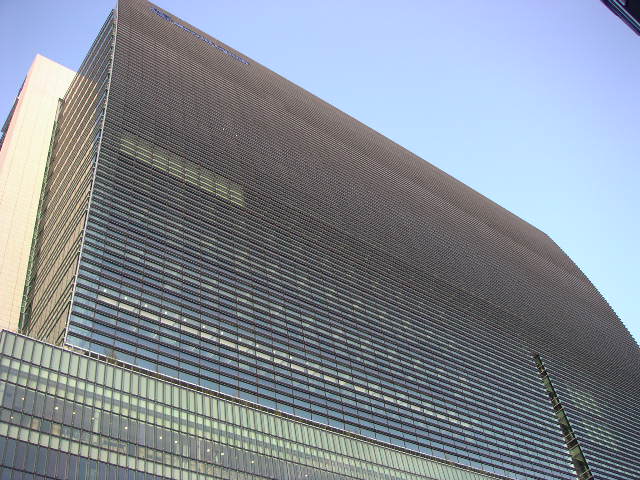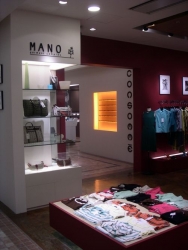History

Nihombashi (also splet Nihonbashi) literally means "Japan Bridge". The neighbourhood grew around the bridge of the same name, first built in wood in 1603. The was the year when shōgun Tokugawa Ieyasu moved his government to Edo. The new ruler of Japan made of Nihombashi the official centre of Edo, and as a result of Japan. Nihombashi has retained its status of official centre of Japan and all distances from Tokyo to other cities in Japan are still measured from that inconspicuous bridge.
Nihombashi was a busy district in the Edo period, built on a network of canals, which served for the merchants to bring their goods directly to the heart of the city. Each area was specialized in some kinds of products : fish, vegetables, clothes...
Nowadays, Nihombashi remains a major business district, but merchants have left place to securities companies and financial institutions. The Bank of Japan and Tokyo Stock Exchange are both located in Nihombashi.


Attractions
Nihombashi being a purely business district it is not on many people's list of places to visit in Tokyo. Nonetheless a stroll around the Muromachi quarter will make you discover some impressive-looking company headquarters, including some built in classical European style that appear to have been transported directly from London or Berlin. This is the case of the Bank of Japan, the Mitsukoshi Department Store, and the adjacent the Mitsui Fudosan Headquarters, housing the Mitsui Memorial Museum.
Shopping

Mitsukoshi, Tokyo's oldest and most prestigious department store, has its main shop in Nihonbashi, and even a subway station to its name (Mitsukoshi-mae).
Near Nihombashi Metro Station is the main branch of Takashimaya, another prestigious department store. Its food court in the basement is reputed for having an array of the very best French pâtissiers, Belgian chocolatiers and Austrian Zuckerbäckern. In front of Takashimaya, you will find Maruzen, one of Japan's leading bookshop. Books in English, French and German are sold on the 4th floor.
The imposing Nihombashi Itchome Building has just opened its door in April 2004. Its architecture is startling, especially for Tokyo, as it is almost entirely glass-covered (earthquake-proof ?) and rounded in a sail-like fashion. It houses the Coredo shopping center from the B1 to 4th flloor, and offices (among which "Merrill Lynch") in the upper floors.



The Neighbourhoods
Nihombashi has the particularity of being divided in "chō" (町), or "quarters". This specificity is only shared by the neighouring Kanda in the whole of Tokyo. The reason is that Kanda and Nihombashi were the economic center in the Edo era and had very specialized areas, sometimes associated in one trade.
Nihombashi is made up of 17 "chō" outside Nihombashi 1-chōme and 2-chōme. These are :
- Hakozakichō 箱崎町 : Mostly residential, although IBM and the Yomiuri Newspaper both have colossal buildings there. It is also home to central Tokyo's highway bus terminal to/from Narita Airport.
- Nakasu 中州
- Hamachō 浜町 : Literally "beach district". Residential neighbourhood
- Ningyochō 人形町 : Literally means "doll district". It is indeed famous for its doll shops dating from the Edo period. Mostly residential and home to the Suiten-gu Shrine (水天宮).
- Kakigarachō 蛎殻町 : Literally "scallop shell district".
- Koamichō 小網町 : Literally "little net district". Business district next to the Tokyo Stock Exchange
- Kayabachō 茅場町 : Literally "thatch place district". Business district with lots of financial institutions.
- Kabutochō 兜町 : Home to the Tokyo Stock Exchange and several securities companies.
- Kobunachō 小舟町 : Literally "little boat district".
- Horidomechō 堀留町 : Literally "moat mooring district".
- Tomizawachō 富沢町 : Literally "rich swamp district".
- Bakurochō 馬喰町 : Literally "horse feeding district".
- Kodenmachō 小伝馬町 : Literally "lesser post horse district".
- Odenmachō 大伝馬町 : Literally "greater post horse district".
- Honchō 本町 : Literally the "main district". Business district with many traditional shops and restaurants
- Muromachi 室町 : Home to Mitsui's Headquarters and Mitsukoshi Department Store (founded by Mitsui).
- Hongokuchō 本石町 : Home to the Bank of Japan.
|
Map of attractions around Nihombashi, Ōtemachi and Marunouchi
Surrounding Areas :